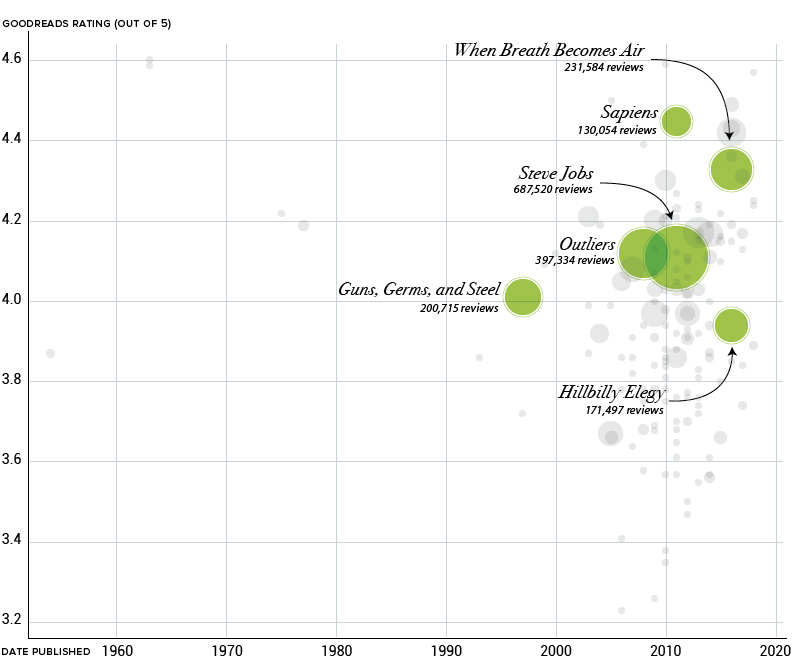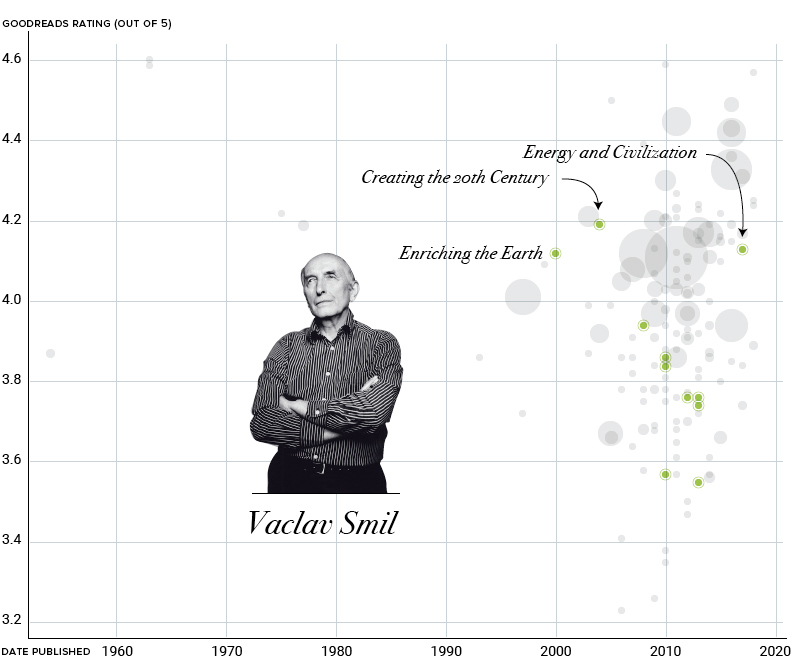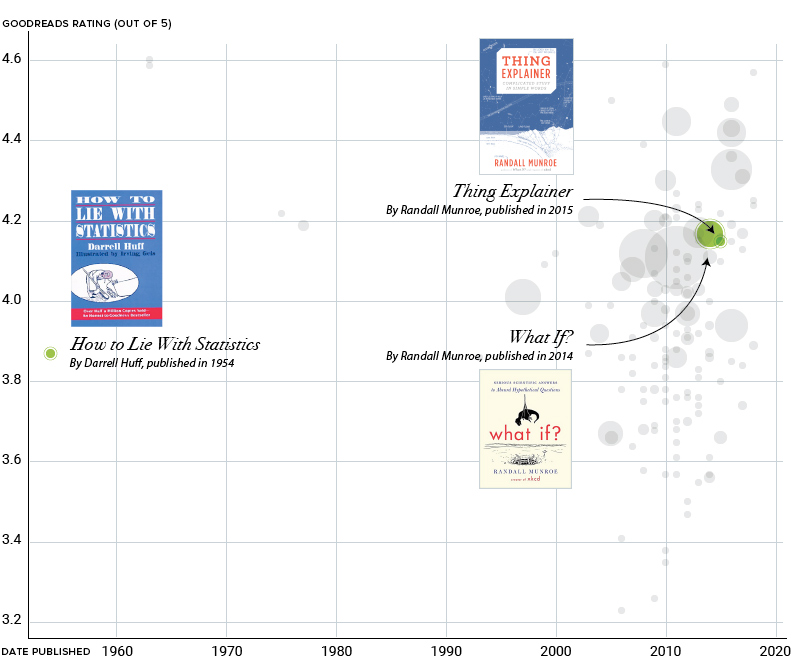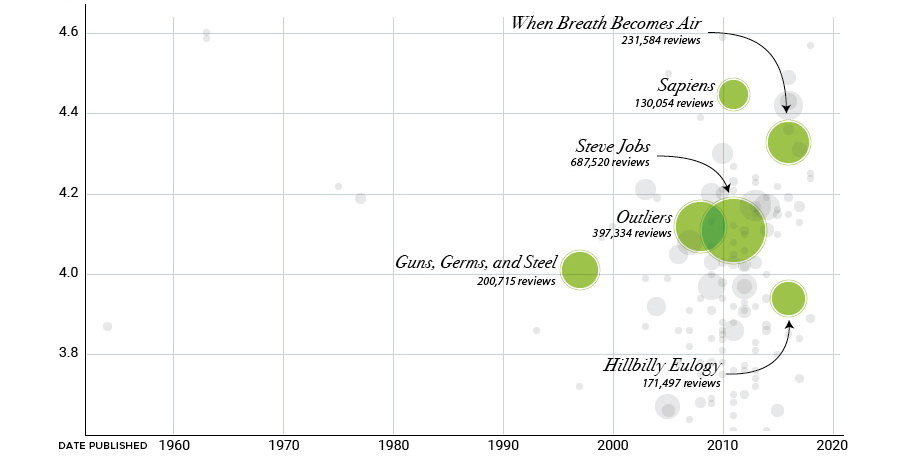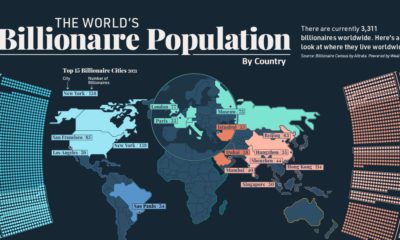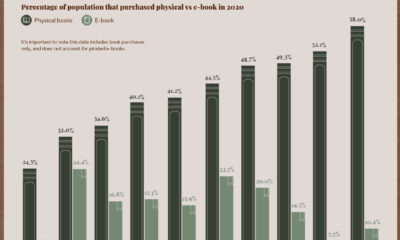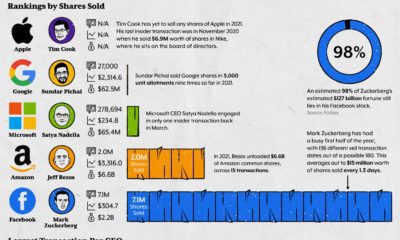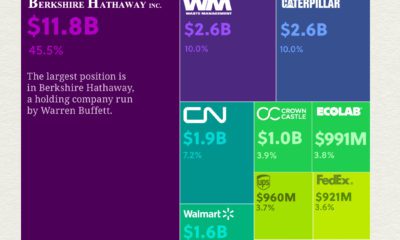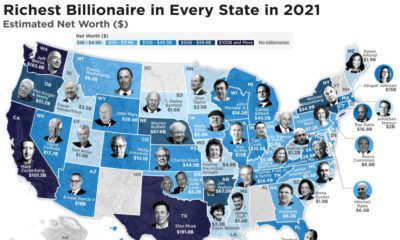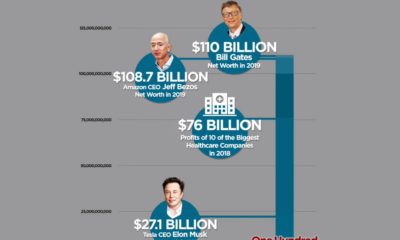The co-founder of Microsoft and heavyweight philanthropist says he reads around 50 books each year, or the equivalent of one per week for those keeping score at home.
The Stamp of Approval
On occasion, a book is so good that Mr. Gates will recommend it on his popular blog, Gates Notes. Over the years, there have been nearly 190 such recommendations on his blog, with underlying themes such as how things work and the quirks of human nature. Today’s visualization below breaks down over 150 of Gates’ nonfiction recommendations by plotting each book based on review scores from GoodReads, one of the world’s most popular sites for book reviews. Meanwhile, the bubbles are sized based on the number of reviews, giving an approximation of the book’s overall popularity.
As an avid reader and influential person, Gates’ book recommendations hold a lot of weight, so it’s worth taking a closer look at the list.
Bill Reads Bestsellers, Too
When between scientific tomes and tennis player autobiographies, Bill Gates reads the bestsellers just like everyone else. More prominent circles on our visualization include now iconic books such as Guns, Germs, and Steel by Jared Diamond, and Steve Jobs, the biography written by Walter Isaacson. There’s something comforting in the fact that one of the world’s richest people is gaining insight from the same book you can borrow from the library for free. There’s no billionaire version of Enlightenment Now.
Vaclav Smil’s Biggest Fan
While Bill Gates has recommended some hugely successful books, he’s also not afraid to introduce his audience to niche selections. A prime example of this is the long list of books by Czech-Canadian scientist and policy analyst, Vaclav Smil. A prolific author, Smil has published dozens of books over his distinguished career that cover topics ranging from global energy to whether humans should be eating meat.
– Bill Gates
Rich Visual Content
Within the long list of books with a conventional format are a few titles that have a decidedly more visual component. Interestingly, they come from books published over a half-century apart. The first example is How to Lie with Statistics by Darrell Huff and illustrated by Irving Geis. This unique book is full of inventive illustrations that help demonstrate concepts that would be cumbersome to explain in text form. In the age of fake news, How to Lie with Statistics has seen renewed popularity, with come help from Bill Gates’ recommendation.
Next, are two books published by Randall Munroe of XKCD fame. These books embrace a more diagrammatic approach to explaining complex concepts in Munroe’s quirky style.
Summer Reading
Based on the popularity of Gates’ recent 5 Books Worth Reading This Summer post, it’s safe to say this body of recommendations will continue to grow. In case you missed it: Visual Capitalist recently published a book called Visualizing Change. Correction: One of the graphics in this post previously listed the book Hillbilly Elegy as “Hillbilly Eulogy”. We regret the error.
on Even while political regimes across these countries have changed over time, they’ve largely followed a few different types of governance. Today, every country can ultimately be classified into just nine broad forms of government systems. This map by Truman Du uses information from Wikipedia to map the government systems that rule the world today.
Countries By Type of Government
It’s important to note that this map charts government systems according to each country’s legal framework. Many countries have constitutions stating their de jure or legally recognized system of government, but their de facto or realized form of governance may be quite different. Here is a list of the stated government system of UN member states and observers as of January 2023: Let’s take a closer look at some of these systems.
Monarchies
Brought back into the spotlight after the death of Queen Elizabeth II of England in September 2022, this form of government has a single ruler. They carry titles from king and queen to sultan or emperor, and their government systems can be further divided into three modern types: constitutional, semi-constitutional, and absolute. A constitutional monarchy sees the monarch act as head of state within the parameters of a constitution, giving them little to no real power. For example, King Charles III is the head of 15 Commonwealth nations including Canada and Australia. However, each has their own head of government. On the other hand, a semi-constitutional monarchy lets the monarch or ruling royal family retain substantial political powers, as is the case in Jordan and Morocco. However, their monarchs still rule the country according to a democratic constitution and in concert with other institutions. Finally, an absolute monarchy is most like the monarchies of old, where the ruler has full power over governance, with modern examples including Saudi Arabia and Vatican City.
Republics
Unlike monarchies, the people hold the power in a republic government system, directly electing representatives to form government. Again, there are multiple types of modern republic governments: presidential, semi-presidential, and parliamentary. The presidential republic could be considered a direct progression from monarchies. This system has a strong and independent chief executive with extensive powers when it comes to domestic affairs and foreign policy. An example of this is the United States, where the President is both the head of state and the head of government. In a semi-presidential republic, the president is the head of state and has some executive powers that are independent of the legislature. However, the prime minister (or chancellor or equivalent title) is the head of government, responsible to the legislature along with the cabinet. Russia is a classic example of this type of government. The last type of republic system is parliamentary. In this system, the president is a figurehead, while the head of government holds real power and is validated by and accountable to the parliament. This type of system can be seen in Germany, Italy, and India and is akin to constitutional monarchies. It’s also important to point out that some parliamentary republic systems operate slightly differently. For example in South Africa, the president is both the head of state and government, but is elected directly by the legislature. This leaves them (and their ministries) potentially subject to parliamentary confidence.
One-Party State
Many of the systems above involve multiple political parties vying to rule and govern their respective countries. In a one-party state, also called a single-party state or single-party system, only one political party has the right to form government. All other political parties are either outlawed or only allowed limited participation in elections. In this system, a country’s head of state and head of government can be executive or ceremonial but political power is constitutionally linked to a single political movement. China is the most well-known example of this government system, with the General Secretary of the Communist Party of China ruling as the de facto leader since 1989.
Provisional
The final form of government is a provisional government formed as an interim or transitional government. In this system, an emergency governmental body is created to manage political transitions after the collapse of a government, or when a new state is formed. Often these evolve into fully constitutionalized systems, but sometimes they hold power for longer than expected. Some examples of countries that are considered provisional include Libya, Burkina Faso, and Chad.
